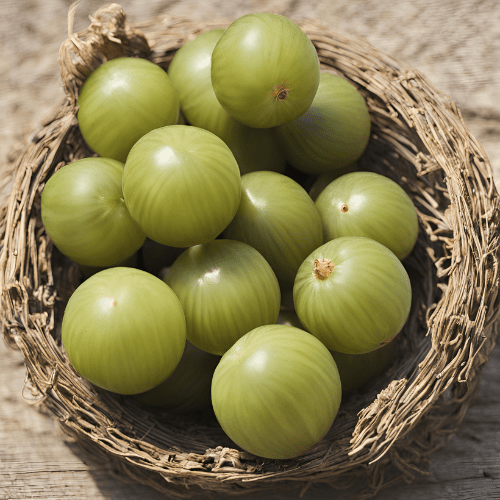Nutritional wonders of 5 ancient Indian superfoods
The land of India is deeply immersed in culture, food, tradition, and history. The rich culinary heritage of India is the central aspect. The traditional superfoods of India are widely praised not just for their flavors but also health-promoting properties. The majority of these foods have been used by people for thousands of years and are integral to Ayurvedic medicine mainly used for healing, wellness, and longevity.
1. Amla: The Rejuvenating Wonder
Amla, scientifically known as Phyllanthus emblica L. or Amalaki in Sanskrit. According to the Indian ancestral stories, Amla was the first tree ever ‘produced in the universe.’
- Amla is rich in antioxidants such as ascorbic acid, and gallic acid and has numerous anti-hyperglycemic, anti-inflammatory, hypoglycemic properties. [1]
- Amla is primarily used for treating digestive disorders; however, it is also utilized in skin and hair care.
- It can potentially brighten the skin due to its significant presence of vitamin C and reduce hair fall.
All parts of the amla tree are used in various Ayurvedic preparations. According to charak Samhita, ancient Ayurvedic text Amla is the best rejuvenating herb.

‘Among all the rasayanas, Amalaki stands out as the most powerful and nourishing, making it the finest of the rejuvenating herbs’
- (Charaka Samhita, Sutrasthana 4:11-13, 16)
2. Makhana/Foxnuts: The Snack with Benefits
Makhana, fox nuts, or lotus seeds are famous for various health benefits. The origin of Makhana dates to over 200 years. It was originally cultivated with a traditional method in Madhubani a region of Bihar in the 18th century and eventually spread to other parts of the country.
In India, the superfood is commonly consumed during fasting because it provides high energy in just a small amount.
- 100 grams of makhana can give anywhere around 347 calories of energy. These are low in fat and rich in fibre and protein making them ideal for weight loss.
- Fox nuts are also rich in magnesium, phosphorous, and potassium.
- Because of its low glycemic index makhana is good for managing diabetes and controlling sugar levels.
With antiaging properties, makhana is also rich in antioxidants. Eating a handful of roasted makhanas every day can make the skin glow and give a younger-looking appearance to the skin. [2]

3. Ghee: Liquid Gold for Health
Ghee is an ayurvedic ‘golden elixir’ and is termed as ‘liquid gold’ because of its status in the context of culture and religious aspects. People have used Ghee for various uses since ancient times, including Vedic rituals such as yajna. Regarding culinary context, ghee is a centermost part of Indian cuisine.
Ghee is a fat derived from butter after the separation of milk solids. Ghee is called ‘Ghrita’ in Sanskrit. According to Ayurveda, ghee promotes intelligence, Agni, memory, ojas, semen, medas, and Kapha. [3]
- Ghee nourishes skin, and hair, preventing dryness as it is rich in vitamins such as A, E, and other fatty acids.
- The presence of Omega 3 in ghee significantly promotes heart health.
- Butyrate content enhances the immune system response of the body. It helps burn fat and provides a sense of satiety.
According to research studies and Ayurvedic principles a spoonful of ghee every day is good for bodily systems and boosting immunity. [4]

4. Coconut: The Nutrient Oasis
In Indian classics, Coconut is often known as ‘Kalpavriksha’ meaning the all-giving tree because every part of the tree is used for something. Coconut in Ayurveda is believed to be the best cooling agent as it is a pitta-pacifier. Cocos nucifera Linn. are commonly found in tropical regions.
- The meat and coconut water are highly nutritious, nourishing the body and preventing diseases.
- The water from coconut is rich in minerals and electrolytes such as calcium, potassium, manganese, antioxidants, and amino acids. [5]
- People have been using coconut as an integral part of traditional medicine for counteracting positions, easing inflammation, killing bacteria, alleviating pain, treating menstrual problems, etc.
- A few other benefits may include boosting heart health, improving digestion, promoting hydration, and boosting skin and hair health.
- Coconut oil is like a magic potion for hair.

5. Drumstick: The Miracle Tree
Drumstick or Moringa oleifera is also known as the miracle tree and has been used in traditional medicine for ages.
- The leaves of the plant are full of minerals, essential vitamins, and amino acids including vitamins such as A, B1, B2, B3, C, iron, magnesium, calcium, phosphorous, etc.
- It also contains significant amounts of antioxidants such as phenolics, carotenoids, and, flavonoids.
Drumstick is referred to as ‘Shigru’ in Ayurveda, balancing Kapha and Vata doshas making it an integral part of the treatment of various health conditions.
A few preliminary studies suggest potential health benefits including regulating blood sugar levels, reducing inflammation, lowering redness, and swelling due to arthritis, protect liver damage caused due to medications. [6]

- Functional and Nutraceutical Significance of Amla (Phyllanthus emblica L.): A Review
- 12 Proven Health Benefits Of Makhana (Fox Nuts)
- Ghee: An Ayurvedic and Biochemical Treatise By: Catherine Robbins
- Little Known Benefits Of Eating A Spoonful Of Ghee Daily!
- Nutritional Profiles, Phytochemical Analysis, Antioxidant Activity and DNA Damage Protection of Makapuno Derived from Thai Aromatic Coconut
- Health benefits of Moringa oleifera

Author: Sanika Pande
- Medicine and Diseases
- Nutrition and Diet


















